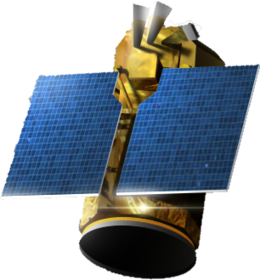


Artist's concept of Formosat-5
| |
| Mission type | Earth observation |
|---|---|
| Operator | NSPO |
| COSPAR ID | 2017-049A |
| SATCAT no. | 42920 |
| Website | Formosat-5 |
| Mission duration | Planned: 5 years Elapsed: 6 years, 10 months, 2 days |
| Spacecraft properties | |
| Manufacturer | NSPO |
| Launch mass | 475 kg (1,047 lb)[1] |
| Dimensions | 1.6 × 2.8 m (5.2 × 9.2 ft)[1] |
| Start of mission | |
| Launch date | 24 August 2017, 18:51 (2017-08-24UTC18:51) UTC[2] |
| Rocket | Falcon 9 FT |
| Launch site | Vandenberg SLC-4E |
| Contractor | SpaceX |
| Orbital parameters | |
| Reference system | Geocentric |
| Regime | Sun-synchronous |
| Semi-major axis | 7,101.4 km (4,412.6 mi) |
| Eccentricity | 0.0009348 |
| Perigee altitude | 716.6 km (445.3 mi) |
| Apogee altitude | 729.9 km (453.5 mi) |
| Inclination | 98.2892° |
| Period | 99.25 minutes |
| Epoch | 25 August 2017, 12:30:14 UTC[3] |
FORMOSAT programme
| |
Formosat-5 (Formosa Satellite 5; Chinese: 福爾摩沙衛星五號) is the first Earth observation satellite manufactured and operated solely by the National Space Organization, the national civilian space agency of Taiwan. The satellite was launched from a Falcon 9 rocket on 24 August 2017, and placed into a Sun-synchronous orbit at an altitude of about 720 km. Formosat-5 can capture color and more detailed monochrome images, along with measuring the ionosphere plasma's properties.
Formosat-5 primary goal is to demonstrate Taiwan's satellite manufacturing capabilities and produce data for various academic research. The satellite is 2.8 m tall, 1.6 m wide octagonal prism body, and weighs about 450 kg. Formosat-5 contains the Optical Telemetry Payload (Chinese: 光學遙測酬載) capturing color and monochrome images, and the Advanced Ionospheric Sounder (Chinese: 先進電離層探測儀) measuring the ionosphere.[4]
The Optical Telemetry Payload is the primary instrument aboard the spacecraft, composed of a telescope and an electrical unit. The telescope uses a CMOS chip designed to see four light wavelengths: blue, green, red, and near infrared. The chip also has a dedicated monochrome sensor with 12-bit color depth. The Optical Telemetry Payload has a 10GB storage device, which can store panoramas that take 8 minutes to capture.[4] Formosat-5 can capture images with a 2-meter resolution in black and white and 4 meters in color.[5]
Formosat-5 also contains a scientific payload, called Advanced Ionospheric Probe, that studies plasma physics and properties in the ionosphere.[6] This instrument can measure plasma composition, density, temperature, and flow rate. The Advanced Ionospheric Probe is expected to be sensitive enough to capture anomalies of the ionosphere before earthquakes.[4]
Other components of Formosat-5 include a power control and distribution unit, heaters, batteries, and foldable solar panels. The power control and distribution unit can output a voltage of 5.2V with a maximum wattage of 50W. Formosat-5's MIPS computer can process 20 million instructions per second, with high-speed data channels.[4]

Formosat-5 is the National Space Organization's first indigenously developed observation satellite, directed by Chang Ho-pen (張和本).[7][8][9][5]
The satellite was flown from Taiwan to Los Angeles International Airport in the United States on 19 July 2017 via a China Airlines transport aircraft, and arrived at Vandenberg Air Force Base on 26 July.[10][11] Launch took place on 24 August 2017 at 18:51 UTC from Vandenberg Space Launch Complex 4 aboard a Falcon 9 rocket.[2]
In September 2017, Formosat-5 transmitted its first images, which were blurry. A subsequent rescue mission fixed the satellite; however, it is limited to capturing images during good weather.[5]
![]() Media related to FORMOSAT-5 at Wikimedia Commons
Media related to FORMOSAT-5 at Wikimedia Commons
|
SpaceX missions and payloads
| |||||||||||||||||||||
|---|---|---|---|---|---|---|---|---|---|---|---|---|---|---|---|---|---|---|---|---|---|
| Launch vehicles |
| ||||||||||||||||||||
| Falcon 1 missions |
| ||||||||||||||||||||
| Falcon 9 missions |
| ||||||||||||||||||||
| Falcon Heavy missions |
| ||||||||||||||||||||
| Starship missions |
| ||||||||||||||||||||
| |||||||||||||||||||||